Our newest case study—Supporting Multiyear Business Transformation—describes how Rent-A-Center (RAC) designed and implemented a series of highly innovative mobile learning and performance coaching solutions for the company’s 18,000-plus employees in over 2,800 retail rental centers across the United States, Canada, and Puerto Rico.
These mLearning initiatives were essential to the success of Rent-A-Center’s multiyear business transformation, which included a new labor model for US stores; a customer-focused, value-based pricing strategy; a new sourcing and distribution model; and new technology in stores. Key to meeting these transformational business challenges was the creation of mobile-based, supportive learning strategies for individual change.
Introducing mobile device rentals
RAC has traditionally offered rentals of items such as brand-name furniture, appliances, and other home-based consumer goods (e.g., televisions). Recently, the company expanded its offerings to include personal technology devices and other forms of mobile communications technologies.
RAC now offers smartphone rentals for customers’ rapidly evolving communications needs. RAC sales associates help customers identify the right smartphone and plan to meet their usage requirements. Because mobile communications technology is evolving year over year to deliver more innovation, consumers often find that a smartphone they have rented lacks the features and functionality that they soon come to need. Therefore, RAC enables its customers to upgrade their existing smartphones to newer models and change their smartphone plans as their individual voice or data needs change.
And a new value proposition
Acceptance Now is a subsidiary of RAC, and its role in the corporation represents a new and important value proposition within the evolving RAC business model. Acceptance Now provides immediate, on-site, virtual application review and approval. This is accomplished by strategically placing kiosks (Figure 1) at retail partner outlets.
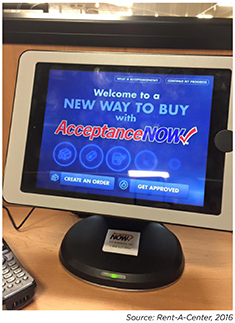
Figure 1: Acceptance Now kiosk screen
Acceptance Now kiosks provide rent-to-own agreements to customers of other retail chains, including Rooms To Go, Ashley Furniture, hhgregg, and Value City Furniture. This value proposition has helped RAC gain traction in the entire lease-to-own market, capturing customers who would have otherwise been lost because they do not qualify for credit.
Business and people challenges
Moving RAC’s consumer sales strategy rapidly into the mobile communications and consumer technology sector created significant business challenges. Among these was the need to move internal business processes away from slower, less efficient paper-based methods and toward technology-enabled processes, which are more agile and responsive to market challenges. Another challenge was the need to update and revitalize the company’s technology infrastructure.
Not surprisingly, people challenges also accompany major organizational transitions of this sort. In addition to adapting to the process and technology changes, RAC employees were challenged to learn new skills and master new workplace technologies to perform their job. This was made more difficult by differences among segments within the RAC workforce.
Learning initiatives
The drive to achieve Rent-A-Center’s business transformation goals necessitated three separate and substantial learning initiatives, which have each presented unique and major challenges to the RAC learning organization.
Smartphone sales—“Mobile Revolution”
RAC learning leaders called their smartphone training initiative the “Mobile Revolution.” Learning leaders knew this was a huge challenge for their unit as well as a major opportunity to create a complex and innovative blended learning program.
The core of the program was built around a two-day, face-to-face learning experience, with all training delivery—including slide decks, video testimonials, online polling, and interactive activities—delivered from the same type of Samsung mobile device that RAC employees would be selling and using during customer interactions (Figure 2). The program included over six weeks of training and 48 individual instructor-led learning sessions in locations from Hawaii to Puerto Rico. A total of 7,000 RAC employees were trained in the Mobile Revolution.
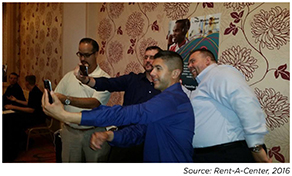
Figure 2: Mobile Revolution selfie activity
As one RAC manager noted:
Using the actual smartphones that would later be sold or rented to RAC customers made the Mobile Revolution training really powerful and served as a major change management component [of the program]. [Using the smartphones for training and coaching] gave training a lot of credibility.
Kiosk application approval—virtual Acceptance Now
An executive vice president of Acceptance Now stated that the program’s success is tied to adoption of “point-of-sale initiatives that have quickly taken root and are revolutionizing the way Rent-A-Center does business.” At the foundation of this approach is rental-approval technology that is integrated into an iPad-based assisted-selling tool. These were piloted in April 2014 and have been rolled out to nationwide kiosks since then, according to an August 2015 news release in Business Wire (see References). The iPads feature proprietary rental-approval software that “automatically renders an application decision while saving time and streamlining the approval process,” the release states.
The RAC training team, using iPads, rolled out similarly designed training for the Acceptance Now rental-approval initiatives. The team developed eLearning modules, numerous job aids, videos, and other resource materials that were housed in a library of material within the iPad. The central learning approach was different in that it used more “self-driven” learning materials housed on the iPad and operations training coaches were not involved.
Using this same approval software, sales associates from RAC retail partners, and the partner customers, could also use the iPad tool to complete transactions on their own. Alternatively, members of the retail partner’s sales team could use the iPad mobile technology “as a side-by-side guided selling tool to lead customers through the rental-approval process,” the news release states.
It is important to note that because the materials were housed on the iPad, it also served as a performance support tool. If the customers or retail partner associates got stuck at any time during a process or workflow, they could have easily accessed job aids or other resources to assist them.
Store manager development program—“Drive: Fourth Gear”
Understandably, all this technology, the new processes, and the organizational change meant that RAC store managers (excluding Acceptance Now managers) were among those most impacted by the company’s transformational push. As a result, the company’s store manager development program, called “Drive: Fourth Gear,” had to rapidly evolve away from the method it was using—a primary focus on eLearning with little to no interaction—to a more agile virtual blended approach with virtual operations training coaches (Figure 3).
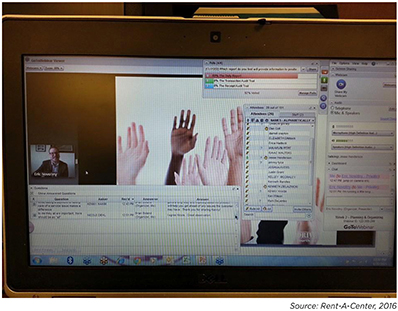
Figure 3: Drive: Fourth Gear virtual class
RAC managers were introduced to a blended 12-week program comprising interactive eLearning modules, virtual instructor-led classes, and hands-on application-based activities. The virtual component comprised seven virtual classes, each with 25 to 35 participants, led by operations training coaches. The purpose of this program was not only to introduce new information and build new skills, but also to reinforce prior learning experiences, build leadership competencies, and improve and accelerate operational readiness. RAC had offered a limited amount of blended training in the past, but this was the first time a new, more innovative “live” component was added.
With a wide range of store managers and high-performing assistant managers from across the company participating in the virtual training, RAC learning leaders found that collaboration, communication, and on-the-job (OTJ) cooperation increased significantly among the training cohort.
Technology platform
RAC’s learning delivery platform (Figure 4) for the Mobile Revolution and improved store visits comprised the following three technology components (separate elements of this platform were used for other learning initiatives):
- Smartphones that provided handheld, immediate access to learning content and reference materials and a wireless mobile device port that enabled all smartphones used within individual stores to operate effectively, even when the location did not provide Wi-Fi access
- Implementation and facilitation of virtual classes
- Mobile presentation software that enabled RAC operations training coaches to deliver person-to-person training and coaching to all employees within the company, regardless of store location or individual job function
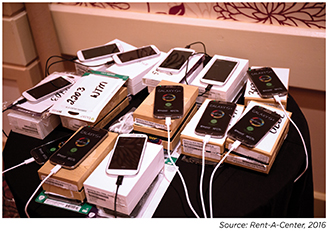
Figure 4: Mobile Revolution training devices
Using their suite of mobile devices and software tools, RAC coaches can perform a multitude of activities, such as explaining a process using virtual slides, showing a video, looking at a process simulation, role-playing with session participants, sitting down one on one for a skill-building exercise, and opening up other virtual activities and materials.
Results
RAC’s mission-critical mLearning initiatives featured in this case study have proved to be exceptionally successful. The leader of the RAC training organization did an outstanding job of describing to other members of the executive team each mLearning initiative and its planned impacts. This was vital because the RAC training team was fairly new to the corporate structure, and training leaders faced a somewhat negative perception of “same old, same old” when it came to training.
However, as each of these mLearning initiatives progressed, the RAC training leader continued to communicate status and ultimate successes to company executives, serving as a highly visible and effective champion for the training organization.
- As for the perceived impact and success of the mLearning initiatives themselves, one RAC coach simply stated that “the training spoke for itself,” and another coach noted, “We have had nothing but accolades; employee turnover has been reduced and OTJ performance has been enhanced. ... [We have been able to shift the culture] and improve morale of field employees.”
- These positive results have also extended to the learning needs and quality of technology adoption achieved within each of the diverse employee constituencies. For example, the training initiatives have been well received by hourly and part-time employees; the one-on-one personal touch of performance coaches has created buy-in and enthusiasm among Gen X employees; and Millennials have embraced the smartphone mobile delivery and technology-enabled sales environment.
Lessons learned
I have summarized some of the key lessons and best-practice suggestions gleaned from RAC’s mLearning initiatives. See the case study for a complete list.
- Do not be afraid to take chances on new technology, but be sure to accommodate the technology and tools learning curve in your project plan so that you can be successful. Learn as much as possible about any new technologies before starting development, especially any best practices that can make your job easier and allow you to deliver a better final product.
- Recognize that technology has the ability to deliver a wow factor for training and can become the most memorable piece of the experience. Because of this potential benefit, RAC found that it was always worth taking the extra time to learn, practice, and perfect learning designs to create a great first impression on learners.
- Keep the learner experience at the forefront when designing learning initiatives. Depending upon the audience, you may need to allocate more or less time for change management, or additional time to help leaders adopt new processes and tools and successfully use the system.
- Deal with the BYOD issue. Because many RAC employees have their own mobile devices, information and learning resources have proved to be somewhat easier to deliver. However, RAC has not yet developed any training programs that rely upon the BYOD approach. Currently, RAC employees at the multi-unit manager level and above are provided with a mobile device and can access some training materials via that device. Workers below that level are not directed to use their personal mobile devices to access or complete assigned training. Operations coaches can and do use both personal and company-provided devices during training.
Looking ahead
RAC learning leaders, training staff, and coaches look to continue their learning innovations in the years ahead. As a team member said, “We want to push the envelope even further, try to be even more innovative.” The RAC team is also looking ahead to several specific challenges:
- Develop learning solutions using HTML5, and then enhance these solutions with innovative options for mLearning.
- Revise current operational metrics for sales of smartphones.
- Better measure OTJ proficiency gained from the initial Mobile Revolution training, and then identify course corrections for future training design that improve performance, knowledge transfer, and operational efficiency.
- Identify how the team can move forward with the design and delivery of on-demand learning solutions.
- Identify ways to speed up training delivery times and become more agile. This will remain an important issue due to hourly-worker churn within the retail industry business model.
- Continue doing a good job of identifying the company’s top business goals, and align with these priorities. Key to this overall effort is continuing to evaluate requests for learning initiatives and resources that best align with the mission-critical goals of company executives.
Conclusion
As we noted in the case study, most people tend to define blended learning straightforwardly, such as “using both online and in-person learning experiences to parallel and complement one another.” However, this case study has illustrated how the Rent-A-Center team was able to create a breadth and depth of learning and individual growth experience that goes far beyond simple online and classroom training.
Beyond their innovative use of mobile technologies and mobile designs, Rent-A-Center’s learning initiatives continue to emphasize what many have called the “human element” in today’s technology-mediated learning environments. The central integrative role played by the RAC operations training coaches/SMEs (Figure 5) emphasizes how important it is for learners of all generations and types to be fully connected and engaged with the human elements of their learning experience.
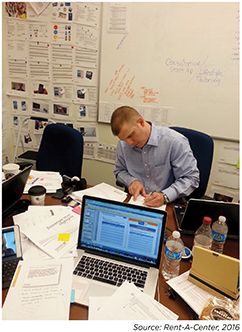
Figure 5: An operations training coach prepares for a session
References
Rent-A-Center. “Same-Store Sales on the Rise at Acceptance Now: Virtual Approvals and Assisted-Selling Tools Help Drive Gains.” Business Wire. 10 August 2015.www.businesswire.com/news/home/20150810006137/en/


